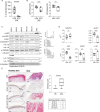High p62 expression suppresses the NLRP1 inflammasome and increases stress resistance in cutaneous SCC cells
- PMID: 36581625
- PMCID: PMC9800582
- DOI: 10.1038/s41419-022-05530-0
High p62 expression suppresses the NLRP1 inflammasome and increases stress resistance in cutaneous SCC cells
Abstract
NLRP1 is the primary inflammasome sensor in human keratinocytes. Sensing of UVB radiation by NLRP1 is believed to underlie the induction of sunburn. Although constitutive NLRP1 activation causes skin inflammation and predisposes patients to the development of cutaneous SCCs, the NLRP1 pathway is suppressed in established SCCs. Here, we identified high levels of the autophagy receptor p62 in SCC cells lines and SCC tumors. Increased NF-κB activity in SCC cells causes p62 up-regulation. Suppression of p62 expression rescues UVB-induced NLRP1 inflammasome activation in early-stage SCC cells. p62 expression protects SCC cells from cytotoxic drugs, whereas NLRP1 sensitizes them. In summary, we identify p62 as a novel negative regulator of the NLRP1 inflammasome in human cutaneous SCC cells, in which suppression of NLRP1 by increased levels of p62 supports stress resistance of skin cancer cells.
© 2022. The Author(s).
Conflict of interest statement
The authors declare no competing interests.
Figures






Similar articles
-
p62 mRNA suppresses NLRP1 expression in cutaneous SCC cells through miR-34a-5p.Cell Death Dis. 2025 Jul 1;16(1):465. doi: 10.1038/s41419-025-07785-9. Cell Death Dis. 2025. PMID: 40593496 Free PMC article.
-
NLRP1 in Cutaneous SCCs: An Example of the Complex Roles of Inflammasomes in Cancer Development.Int J Mol Sci. 2022 Oct 14;23(20):12308. doi: 10.3390/ijms232012308. Int J Mol Sci. 2022. PMID: 36293159 Free PMC article. Review.
-
The NLRP1 Inflammasome in Human Skin and Beyond.Int J Mol Sci. 2020 Jul 6;21(13):4788. doi: 10.3390/ijms21134788. Int J Mol Sci. 2020. PMID: 32640751 Free PMC article. Review.
-
The NLRP1 Inflammasome Pathway Is Silenced in Cutaneous Squamous Cell Carcinoma.J Invest Dermatol. 2019 Aug;139(8):1788-1797.e6. doi: 10.1016/j.jid.2019.01.025. Epub 2019 Feb 7. J Invest Dermatol. 2019. PMID: 30738816
-
NLRP1- A CINDERELLA STORY: a perspective of recent advances in NLRP1 and the questions they raise.Commun Biol. 2023 Dec 16;6(1):1274. doi: 10.1038/s42003-023-05684-3. Commun Biol. 2023. PMID: 38104185 Free PMC article. Review.
Cited by
-
NLRP1 inhibits lung adenocarcinoma growth through mediating mitochondrial dysregulation in an inflammasome-independent manner.Braz J Med Biol Res. 2024 Sep 6;57:e13885. doi: 10.1590/1414-431X2024e13885. eCollection 2024. Braz J Med Biol Res. 2024. PMID: 39258674 Free PMC article.
-
Autophagy- and oxidative stress-related protein deregulation mediated by extracellular vesicles of human MJD/SCA3 iPSC-derived neuroepithelial stem cells and differentiated neural cultures.Cell Death Dis. 2025 May 15;16(1):383. doi: 10.1038/s41419-025-07659-0. Cell Death Dis. 2025. PMID: 40374597 Free PMC article.
-
Palmatine treats urticaria by reducing inflammation and increasing autophagy.Front Immunol. 2023 Nov 14;14:1268467. doi: 10.3389/fimmu.2023.1268467. eCollection 2023. Front Immunol. 2023. PMID: 38035098 Free PMC article.
-
p62 mRNA suppresses NLRP1 expression in cutaneous SCC cells through miR-34a-5p.Cell Death Dis. 2025 Jul 1;16(1):465. doi: 10.1038/s41419-025-07785-9. Cell Death Dis. 2025. PMID: 40593496 Free PMC article.
References
Publication types
MeSH terms
Substances
LinkOut - more resources
Full Text Sources
Research Materials

